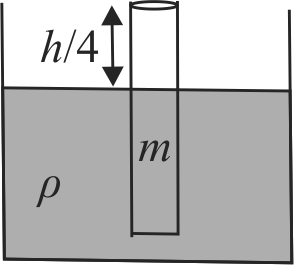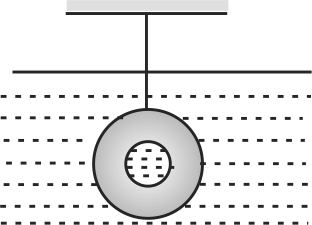360988
A solid cylinder of height \(h\) and mass \(m\) is floating in a liquid of density \(\rho\) as shown in the figure. Find the acceleration of the vessel containing liquid for which the relative downward acceleration of the completely immersed cylinder w.r.t. vessel becomes equal to one-third of that of the vessel. (Take \(g=10 {~m} / {s}^{2}\))
360988
A solid cylinder of height \(h\) and mass \(m\) is floating in a liquid of density \(\rho\) as shown in the figure. Find the acceleration of the vessel containing liquid for which the relative downward acceleration of the completely immersed cylinder w.r.t. vessel becomes equal to one-third of that of the vessel. (Take \(g=10 {~m} / {s}^{2}\))
360988
A solid cylinder of height \(h\) and mass \(m\) is floating in a liquid of density \(\rho\) as shown in the figure. Find the acceleration of the vessel containing liquid for which the relative downward acceleration of the completely immersed cylinder w.r.t. vessel becomes equal to one-third of that of the vessel. (Take \(g=10 {~m} / {s}^{2}\))
360988
A solid cylinder of height \(h\) and mass \(m\) is floating in a liquid of density \(\rho\) as shown in the figure. Find the acceleration of the vessel containing liquid for which the relative downward acceleration of the completely immersed cylinder w.r.t. vessel becomes equal to one-third of that of the vessel. (Take \(g=10 {~m} / {s}^{2}\))
360988
A solid cylinder of height \(h\) and mass \(m\) is floating in a liquid of density \(\rho\) as shown in the figure. Find the acceleration of the vessel containing liquid for which the relative downward acceleration of the completely immersed cylinder w.r.t. vessel becomes equal to one-third of that of the vessel. (Take \(g=10 {~m} / {s}^{2}\))
